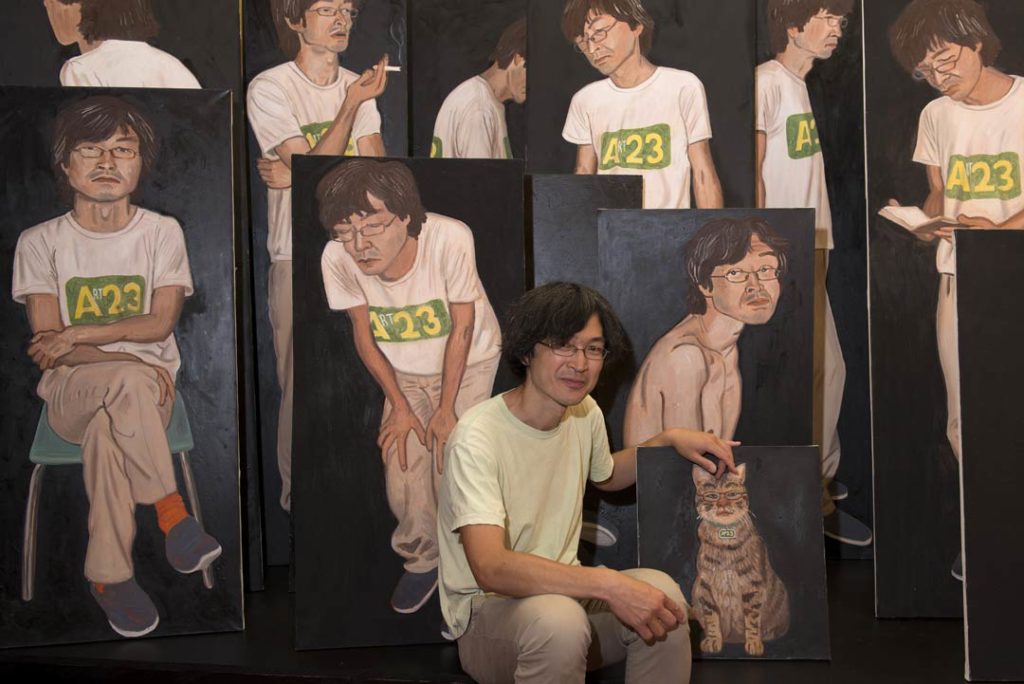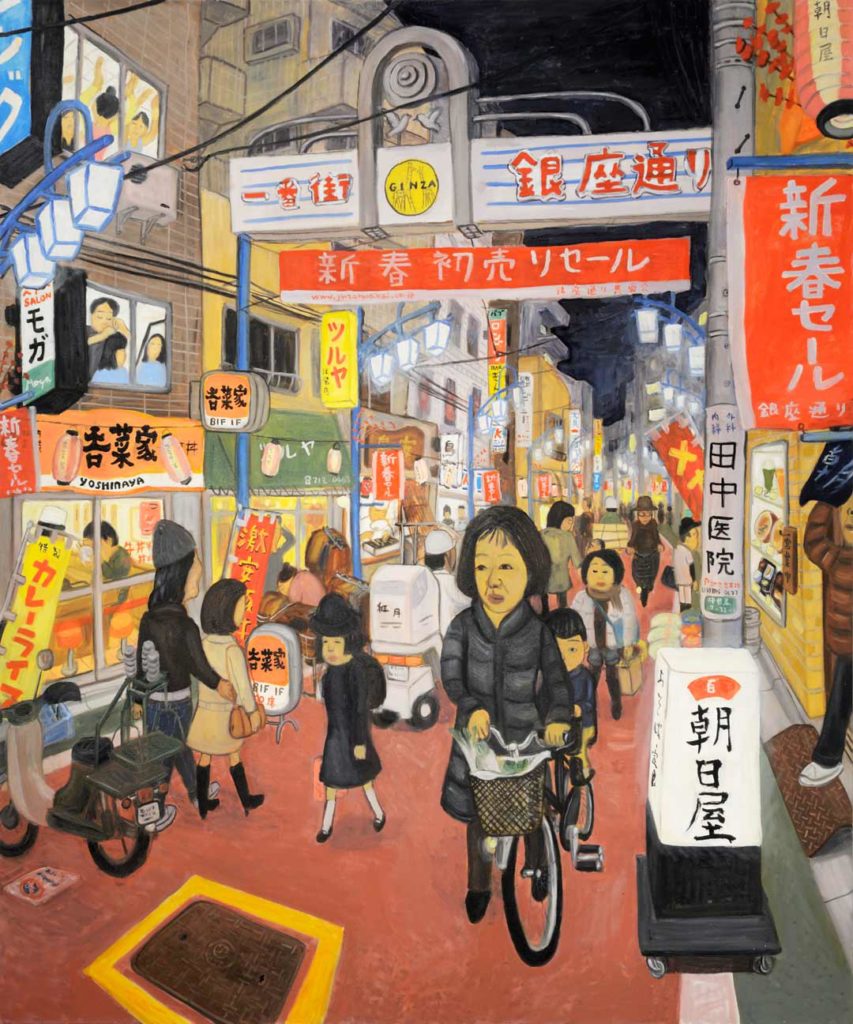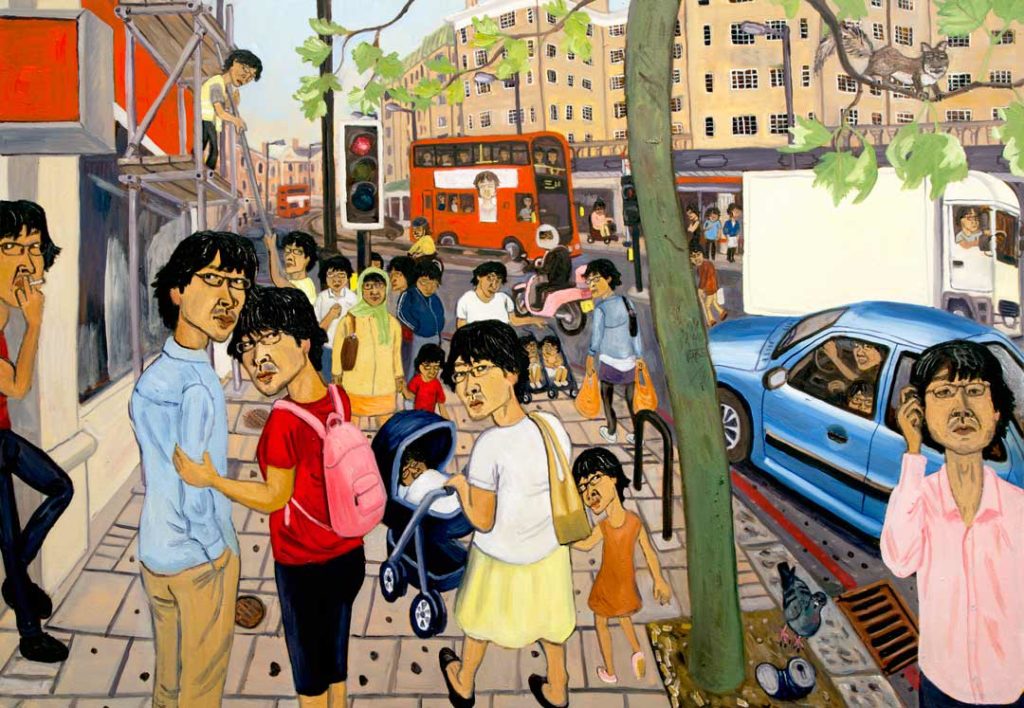Next, in our ‘Why I love Japan’ series, which aims to share the work of some of the Nakama team’s favourites artists, photographers, and craftspeople, we’re pleased to announce illustrator Jiro Osuga, an artist whose playful work captures his experiences of London and Tokyo. Born in Japan, but raised in London, Jiro Osuga delves into his experience of living somewhere in between both cultures.

© Torla Evans
“I sometimes wonder how much of what I always understood to be purely personal traits, such as my shyness or my work-ethic are in fact products of cultural conditioning during my early years in Japan”
What is your affinity with and experience of Japan?
I am Japanese. I was born in Tokyo in 1968, and spent half my childhood in Japan, the other half mainly in the UK, where my father’s job had taken the family. The entirety of my adult life has been lived in the UK, but I have been visiting Japan once a year for the last thirty years.
How has your experience of Japan and Japanese culture impacted your life (if it has)?
The things that you pick up in your formative years never leave you. I don’t think I will ever be totally anglicised, despite having lived in London for forty years in total. I sometimes wonder how much of what I always understood to be purely personal traits, such as my shyness or my work ethic are in fact products of cultural conditioning during my early years in Japan.
Japan did impact me in a major and negative way earlier in my childhood. When in 1976 my family and I returned to live there after several years abroad, I had great difficulty in re-adjusting to the culture. I was then aged eight. I barely spoke the language after the years abroad and had no notion of the social norms that were expected of me at school – the Confucian hierarchy, group-think, and regimented teaching methods were all strange to me. I failed to fit in and was mercilessly bullied by my peers. I sought refuge from this trauma in imaginary personal worlds that I created for myself, to which no bully, teacher, or any other grown-up had access. These eventually developed into my art, so in a way, it was the experience of rejection by the country of my birth that had made me an artist.
Happily, my difficult years in Japan came to an end when my family returned to the UK in 1980. But the damage was done, and to this day, my attitude towards Japan remains ambivalent. Over my many visits to Japan as an adult, I have come to love many aspects of Japan – not just the arts and the visible aspects of contemporary urban life, but broader societal traits such as courteousness and attention to detail. But I am still repelled by the tendency of the Japanese to prioritise the cohesion of the group over the happiness of the individual and to do so by having everyone unthinkingly adhere to what are often meaningless and sentimental slogans rather than verifiable truths. This tendency was much in evidence during the Fukushima disaster of 2011. In the face of catastrophe, the people displayed an admirable level of stoicism that was much commented upon in the west. But the corollary of that solidarity was that people were disinclined to question the powers that be, who were either running around like headless chickens when decisive action and clear communication was called for or desperately trying to save face rather than cater for the well-being of the people.
Having grown up in two different countries, I also suffered from a mild identity crisis for many years. On the one hand, it is a privilege to be a trans-national – you have a detached perspective on both countries that would be much harder for a born-and-bred native to cultivate. But at the same time, it means that you lack a genuine sense of continuity and belonging to either your place of birth or your adopted home. You are neither bird nor beast. This question of identity was the subject of much soul-searching earlier on in my life, but I worry about it much less in recent years. I now accept that I am a classic “Anywhere” rather than “Somewhere” person and that I draw my sense of myself from a multiplicity of sources. After all, this is the story of millions of other people in our globalised age, and compared to many, I have it easy – my allegiance is split between two peaceful, prosperous democracies.
Has Japanese art influenced your work? If so, are there any particular artists or collections that you’d recommend other people check out?
People have often said that my work looks Japanese, especially manga comics. This is unsurprising given that I read manga growing up in Japan, and had made crude attempts at my own comic books as a child. My relaxed attitude towards important tenets of western art such as perspective, chiaroscuro, and naturalism (which are either absent or of secondary importance in the Japanese tradition) may also have been picked up unconsciously during my years in Japan.
But most of my knowledge of Japanese art is the result of conscious study since my teens. By then I was living in the UK, so to start with, this effort to understand my native culture was pursued vicariously through books and visits to collections in London museums. Later on, as I started to visit Japan on an annual basis, I made a point of checking out museums and galleries on each visit.
My favourite Japanese art all comes from the past. I have little interest in the contemporary art scene. In many ways, I am attracted more to the decorative arts than to painting. Japanese lacquerware and textiles are often remarkable for their strikingly modern-looking abstract designs, and for their use of bold asymmetrical compositions, which is probably unique amongst the decorative arts of the world.
Of the painters, I have always been fond of the Rimpa school and its two great masters, Tawaraya Sotatsuand Ogata Korin. Again, with these artists, it is their bold use of space that appeals to me. Among the Ukiyo-e artists, I am always impressed by the sheer inventive energy of Hokusai, who I think is the Picasso of the woodblock print. On a different tenor, a few years ago in Tokyo, I saw an exhibition of the work of Mokujiki, an itinerant monk who carved wooden Buddhas on his travels up and down Japan. These are rough-hewn sculptures in what might be called a “naïve” style, but they have a real sense of benign spirituality about them. A sophisticated appreciation of the less-than-polished is another unusual feature of Japanese aesthetics.
Having said all this, I am far from a partisan nationalist when it comes to my influences. In fact, I am an omnivorous cultural appropriator. I have studied the western tradition going as far back as the Egyptians as assiduously as the Japanese, and have been attracted by the creativity of cultures from around the world: Korean ceramics, Persian and Indian miniatures, Aztec codices to name but a few.


Can you tell me a little more about your work, the inspiration behind it, and its connection to Japan?
All my work is drawn from my own personal experience of day-to-day life. I might make a painting about walking down the street, shopping at a local supermarket, or a tree I cycle past on my way to my day job. Whatever intrigues me one way or other, I paint. My work is always unashamedly subjective, and self-portraits, thinly disguised or otherwise, often pop up in the paintings. I am not averse to humour in my work – so a painting of an airport might be peopled by anachronistic historical characters, and everyone depicted in a south London street might have my face, including the squirrel!
Of the formal elements that make up a painting, perhaps the manipulation of space has consistently fascinated me the most. I am fond of painting on extremely long and narrow canvases and have experimented with free-standing screens that are painted on both sides, as well as interactive paintings on hinged panels that the viewer can open and close. It is easy to discern a Japanese influence in this aspect of my work. Scrolls and screens are standard formats in traditional Japanese painting.
Most of my output feature London, where I have lived and worked all my professional life. But as an annual trip to Japan (usually at Christmas time) is a key event in my calendar, I have made a great many Japan-inspired paintings over the years. During my visits, I roam the streets of Tokyo sketchbook in hand, absorbing everything I see, and then make large paintings based on these sketches back in my London studio. In 2011, I had an exhibition comprising entirely of my Japan-themed paintings at Flowers Gallery in London, which sought to re-create something of the sensation of roaming the streets of Tokyo within the gallery space. The show was in a way, the culmination of my effort to resolve my sometimes-conflicted relationship with Japan. Perhaps I succeeded in arriving at a resolution – in recent years I have made far fewer Japan-related paintings.
What are you working on at the moment?
I am currently putting the finishing touches to a large canvas of a panoramic view of London from atop a hill. Actually, it is based on the view from the eleventh floor of the office block of my last day job, where I sneaked up during breaks to sketch. The hill is fictitious, as are the locations of most of the buildings in the middle ground, which are in fact transplants of all the places that relate to my personal histories in the city, such as the various addresses I have lived in over the years, my secondary school and the art schools where I studied.
I have also prepared a long, narrow canvas on which I will be painting the stretch of the Thames between Barnes and Kew that I cycled along on my daily commute to my day job. Again, this will not be a straightforward landscape – one end of the painting will show the river in winter-time, the seasons progressively changing to spring and then summer as you travel further upriver towards the other end of the canvas.
Another painting in the pipeline is a view from the top deck of a 319 bus near Clapham Junction. I plan to ride the bus again next week to refresh myself on what it looks like and make a few more preparatory drawings. The view from the upper deck of a bus is, in my opinion, the best view in London, wherever the bus is travelling.
















































